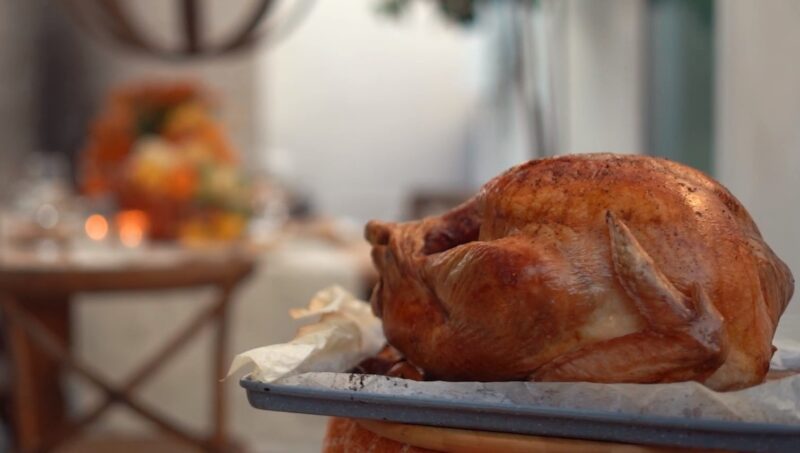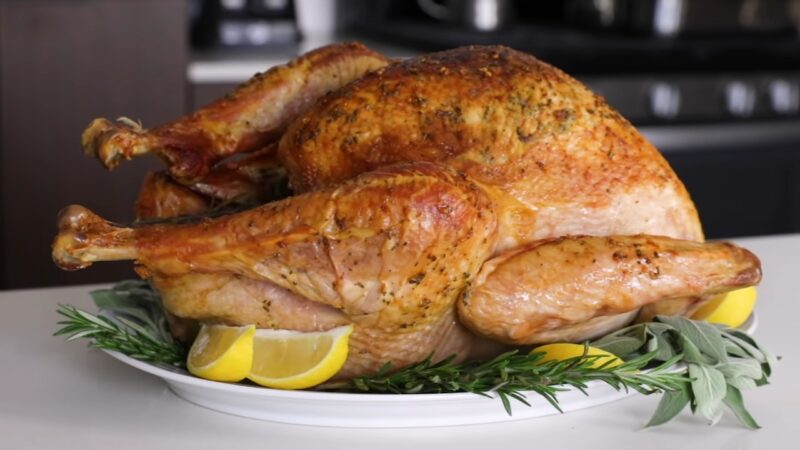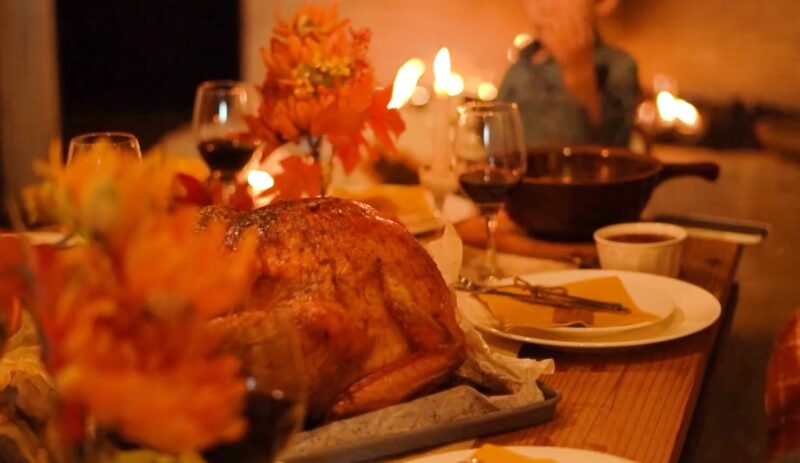Thanksgiving is undeniably one of the most anticipated holidays of the year. It’s a day filled with joy, gratitude, and the comforting scent of a turkey roasting to perfection.
The house smells great, and everyone’s excited, even if you cooked a different meat for everyone. But imagine the surprise when you open the oven, expecting to see a turkey that still has some time to go, only to find it’s already done.
Way ahead of schedule. The initial reaction might be to panic, but there’s no need for that.
We’re here to guide you through this unexpected turn of events. This comprehensive guide will explore the reasons behind your turkey’s accelerated cooking time and offer solutions to ensure it remains the centerpiece of your Thanksgiving feast.
The Speedy Turkey

Before we jump into the solutions, it’s crucial to grasp why your turkey might have raced through its cooking process. Firstly, the size of the turkey plays a significant role.
If you’ve chosen a bird that weighs less than 12 pounds, it’s naturally going to cook faster than its heftier counterparts. Then there’s the matter of the oven.
Not all ovens heat the same. Some can be hotter than they indicate, even if they’re set at the same temperature as another oven.
This is why many seasoned cooks swear by the reliability of an oven thermometer. Lastly, the way you’ve prepared your turkey can also affect its cooking time.
For instance, if you’ve treated your turkey to a brine bath, it can hasten the cooking. Similarly, a spatchcocked turkey, with its flattened profile, allows for more even and quicker cooking.
The Art of Keeping Your Dish Warm

Now, you’re faced with a turkey that’s ready to be served, but dinner is still a long way off. The challenge here is to keep it warm without sacrificing its juiciness.
One tried and tested method is to loosely cover the turkey with aluminum foil. This simple step helps in retaining the warmth without making the skin lose its crispness.
Another approach is to use your oven’s warming setting. By setting it to a low temperature, around 200°F, and placing the turkey inside, you can ensure it stays warm.
Just remember not to leave it in there for more than an hour to prevent overcooking. For added moisture, consider adding a splash of chicken or turkey broth to the bottom of the roasting pan.
This not only prevents the meat from drying out but also adds an extra layer of flavor.
Mastering the Reheat

Sometimes, the gap between the turkey being ready and dinner time can be quite long. In such cases, reheating becomes inevitable.
The key is to do it in a way that doesn’t compromise its taste or texture. Using the oven is the most recommended method.
Set it to 325°F, place the turkey in a roasting pan, introduce some broth for moisture, and cover with foil. The goal is to get the internal temperature back to a safe 165°F.
While microwaving is quicker, it’s not the ideal method for a whole turkey. However, if you’re in a real hurry, slice the turkey and microwave it in short bursts, ensuring even reheating.
Complementing Your Dish

Even if your turkey has been cooked earlier than expected, with the right accompaniments, it can still shine at the dinner table. A luscious, piping-hot gravy can work wonders.
It not only adds flavor but can also mask any textural imperfections that might have arisen due to the early cooking. The zesty tang of cranberry sauce is another must-have.
Its sharpness contrasts beautifully with the savory notes of the turkey. And let’s not forget the side dishes.
Classics like warm mashed potatoes, green bean almondine, and a hearty stuffing can sometimes steal the show, especially if the turkey is slightly over or underdone.
Avoiding the Early Bird Situation
For future reference, here are some tips to ensure your turkey cooks just in time:
- A meat thermometer is a game-changer. It gives you precise control, allowing you to monitor the turkey’s internal temperature.
- Get to know your oven. Regular calibration or the use of an oven thermometer can help in maintaining accurate temperatures.
- Lastly, always rely on trusted recipes. They often provide clear guidelines based on the weight of the turkey, ensuring optimal cooking times.
Recommended Easy Turkey Recipes To Try
While the traditional roast turkey is a Thanksgiving staple, there are countless ways to prepare this versatile bird. Here are a few easy-to-follow recipes that will make your turkey the talk of the table:
Herb-Butter Roasted Turkey
Ingredients:
- 1 whole turkey (12-14 pounds)
- 1 cup unsalted butter, softened
- 3 tablespoons fresh rosemary, minced
- 3 tablespoons fresh thyme, minced
- 3 garlic cloves, minced
- Salt and pepper to taste
- 1 lemon, halved
- 1 onion, quartered
Instructions:
- Preheat your oven to 325°F (165°C).
- In a bowl, mix together the softened butter, rosemary, thyme, garlic, salt, and pepper.
- Clean the turkey and pat it dry. Loosen the skin and rub the herb-butter mixture under and over the skin.
- Stuff the turkey cavity with lemon halves and onion quarters.
- Place the turkey on a roasting rack and roast for about 3 hours or until the internal temperature reaches 165°F (74°C).
- Let it rest for 20 minutes before carving.
Maple-Glazed Turkey
Ingredients:
- 1 whole turkey (12-14 pounds)
- 1 cup maple syrup
- 1/2 cup melted butter
- 2 teaspoons ground cinnamon
- Salt and pepper to taste
Instructions:
- Preheat the oven to 325°F (165°C).
- In a bowl, whisk together maple syrup, melted butter, cinnamon, salt, and pepper.
- Clean the turkey and pat it dry. Brush the turkey with the maple glaze.
- Place the turkey on a roasting rack and roast, basting every 30 minutes with the remaining glaze, for about 3 hours or until the internal temperature reaches 165°F (74°C).
- Let it rest for 20 minutes before carving.
Lemon-Garlic Slow Cooker Turkey Breast
Ingredients:
- 1 bone-in turkey breast (6-7 pounds)
- 4 garlic cloves, minced
- Zest and juice of 2 lemons
- 1/4 cup olive oil
- 1 teaspoon dried oregano
- Salt and pepper to taste
Instructions:
- In a bowl, mix together garlic, lemon zest, lemon juice, olive oil, oregano, salt, and pepper.
- Rub the mixture all over the turkey breast.
- Place the turkey breast in the slow cooker, skin side up.
- Cook on low for 5-6 hours or until the internal temperature reaches 165°F (74°C).
- For crispy skin, place the cooked turkey breast under a broiler for 3-4 minutes.
- Let it rest for 10 minutes before slicing.
FAQs
Can I still use the drippings from the turkey for gravy if I’ve added broth to the roasting pan?
Absolutely! The drippings, combined with the added broth, can create a richer and more flavorful gravy. Just remember to adjust the seasoning as the broth might add extra saltiness.
I don’t have an oven thermometer. Are there other ways to check if my oven is running hotter than it should?
Yes, you can do a simple test by baking a store-bought loaf of bread or a pre-made pizza. If they cook faster than the recommended time, your oven might be running hot.
If I’ve brined my turkey, should I adjust the cooking time to account for faster cooking?
Brining can indeed speed up the cooking process. It’s best to monitor the turkey’s internal temperature closely, starting earlier than the recipe suggests, to ensure it doesn’t overcook.
Can I use the microwave method for reheating if my turkey is larger than 12 pounds?
For larger turkeys, it’s best to slice the meat first and then reheat in batches in the microwave. This ensures even reheating and prevents the turkey from becoming too dry.
How long can I safely keep the turkey warm in the oven without it drying out?
Ideally, you shouldn’t keep the turkey in a warm oven for more than an hour. If you need to extend this time, ensure you’ve added broth and covered the turkey to retain moisture.
Are there alternative herbs or spices I can use for the Herb-Butter Roasted Turkey recipe if I don’t have rosemary or thyme on hand?
Certainly! Sage, marjoram, or even parsley can be great alternatives. Feel free to get creative with your favorite herbs to give your turkey a personal touch.
Wrapping Up
An early-done turkey might seem like a hiccup in your Thanksgiving preparations, but with the right strategies, it doesn’t have to be a deal-breaker. With a bit of patience and the techniques mentioned above, your turkey will remain succulent and delicious.
After all, Thanksgiving is as much about the love and memories shared as it is about the food. So even if things don’t go exactly as planned, embrace the moment and the joy of the occasion. But if you want to prepare something else this season check our article about preparing Skirt Steak for many people.
Here’s to a memorable feast!
